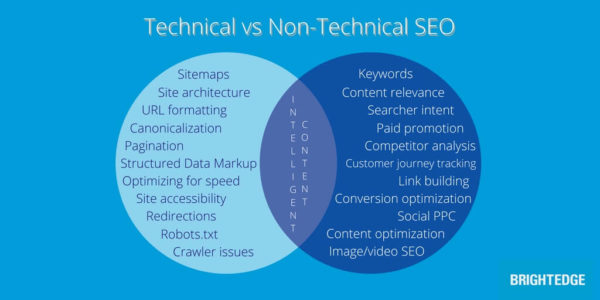5 ways to balance technical & non-technical SEO
Though tactics and strategies differ greatly for technical and non-technical SEOs, columnist Jim Yu believes it’s critical that they find ways to work together. Each is powerful on its own, but it’s in the combined efforts of both that the real magic happens.
In SEO’s earlier days, technical SEO was largely about coding. For a fun throwback, check out this 2008 SEL article on search-friendly code by Jonathan Hochman, an internet marketer and computer sciences grad from Yale. Technical SEO was all about how to optimize (and often, manipulate) code, metadata and link profiles to achieve better results.
And you know what? That basic purpose of technical SEO hasn’t changed.
As black hat tactics and manipulation became less effective and more dangerous, they fell out of favor. This gave rise to the more creative, non-technical SEO tactics designed to show search engines the value and relevance of each piece of content.
Technical and non-technical should never be pitted against one another, as both are critical to the health of your site and the success of your campaigns. Technical SEO is the framework on which truly great content is built, ensuring that each piece is structured and optimized for search engine discoverability and human consumption.
Here are a few tips to help you find balance between the technical and creative:
1. Understand the role of technical SEO in your organization
Today, in most organizations, technical SEO is a function entirely separate from development. You might still have some spillover between development and SEO in small companies or with freelancers. Typically, though, SEOs are an entity unto themselves, tasked with working alongside:
- the uber-technical IT team, who manage the reception and storage of critical customer data.
- web developers.
- the non-technical SEOs (including link builders and content marketers).
As a sort of translator between these fundamentally different teams, technical SEOs understand the needs of each. They can anticipate how a new data security policy implemented by IT might affect a forward-facing marketing campaign or activity. They know the limitations of the site and can knowledgeably consult with developers to see whether what marketing wants is possible, or offer alternatives. Most importantly, they inform each of these teams on how their activities can stay compliant with (and be optimized for) search engines.
The second part of the technical SEO’s job is then implementation, adding the structure and optimizations to assist the engines in retrieving, indexing and ranking content.
This is why it’s critical that a technical SEO is a part of the planning process. Too often, they’re seen as “fixers,” brought in to identify and correct problems that were perfectly preventable. Instead, SEO and content teams should be working together to establish shared goals, work as a cohesive unit, measure and analyze, and continually adapt.
2. Balance your on-page & off-page optimization
On-page and off-page strategies each offer very different benefits, but both impact your content performance dramatically. As you strive to find balance between the technical and non-technical, factor in your on- and off-page optimizations:
On-page SEO:
- Your site’s structure, hierarchy and design
- Title tags and meta descriptions
- Coding errors
- Crawl- and index-ability
- Internal linking
- Sitemaps
- Page content
- Site speed
- Mobile-friendliness
Off-page SEO:
- Social content and sharing
- Influencer content
- Articles and guest blogs
- Inbound links
3. Define the responsibilities of each type of SEO
So, which tasks belong to technical SEOs, and which belong to non-technical SEOs? There are tasks that are very obviously one or the other. For example, deciding how to use subdomains and designing your site’s architecture are clearly technical tasks, while authoring engaging, optimized content is for your non-technical/creative team.
But there are areas of overlap that can cause confusion, or get missed altogether, unless you clearly define who is responsible for which SEO tasks. This can create site issues that have a devastating impact on consumer experience — and ultimately, your sales — as a result. On average, organic search drives fully 60 percent of website traffic. Chances are, it’s your largest channel. It’s worth getting right.
On-page and off-page, the technical and the non-technical, the scientific and the creative — each is powerful on its own, but it’s in the combined effort of both that the real magic happens. We saw a perfect example of this in the multi-faceted approach to content marketing undertaken by business products retailer Quill (disclosure: customer).
In their pursuit of increased organic traffic and e-commerce revenue, Quill’s SEO program manager, Eugene Feygin, devised and implemented a new company-wide content strategy. Within it, he restructured the brand’s content housing, factored in external partners’ research, and developed new content agency partnerships. Quill’s website got a user experience-centric overhaul to simplify navigation and make the content journey more intuitive. Feygin deployed BrightEdge’s Data Cube tool to identify Quill’s most pressing content gaps and greatest opportunities.
The results of this holistic approach marrying the science of content data and site structure with the creativity of ingenious promotion and partnerships was astounding.
Quill’s balanced approach to SEO grew their organic blog traffic by 270 percent in a single year. Their page one keywords exploded by 800 percent, and they achieved 98 percent search engine indexation.
4. Work SEO into your content workflow
Traditionally, magazines and other publishers used an in-house style guide to make clear their content rules and expectations. These are an important tool for brands not only to create consistency in style and tone, but to ensure that each piece of content gets the same SEO treatment pre-publication and during promotion.
How are images optimized? Which types of sources are approved as citations and for external linking, and are there any you avoid? When and how should you use H1, H2 and H3 headings? Who creates title tags, and what rules are there around those? Who are your readers, and what is their assumed level of knowledge about your topic or industry? (This can help guide keyword selection.)
Getting all of this documented provides a quick reference baseline for your content creators. It gives your creative team a resource created with technical SEO input that guides the content creation process. When you place this optimized content into the technically sound framework managed by your technical SEO, ready to be promoted by your content marketers, it’s a truly powerful combination indeed.
5. Balance technical & non-technical at budget time, too
Local media forecaster Borrell expects SEO spend in the US to reach almost $80 billion by 2020. C-level decisions around budget allocation need to reflect this holistic approach to SEO as an integral component of your overall marketing strategy. Technical SEOs shouldn’t have to fight for a piece of the content marketing budget; that’s the mentality that supports silos and keeps teams competitive.
Budgeting for SEO can be difficult, as organic doesn’t have direct media costs. The potential for high returns is there, but it takes organization-wide acceptance of a data-driven strategy to make it happen. Earlier this year, I shared a few tips to help SEOs learn to evangelize their practice to colleagues across departments and the C-suite. Doing so builds a strong case for the organization-wide implementation of and adherence to holistic SEO with the budget to make it possible.
Finding your SEO balance and bringing it all together
Technical and non-technical SEO tactics and strategies differ greatly; you might have entirely different teams executing each. Even so, it’s critical that they find ways to work together, as those intersections are where your greatest opportunities lie.
In the increasingly competitive SERPs, where you’re vying for the eyes and minds of intelligent, informed consumers, the marriage of technical SEO with the art of content marketing enables the creation of the intelligent content you need to stay on top.
Contributing authors are invited to create content for Search Engine Land and are chosen for their expertise and contribution to the search community. Our contributors work under the oversight of the editorial staff and contributions are checked for quality and relevance to our readers. The opinions they express are their own.
Related stories
New on Search Engine Land

